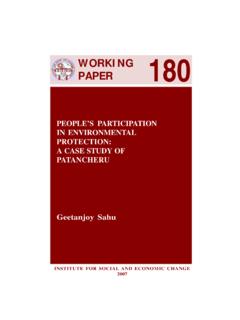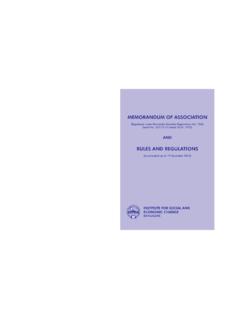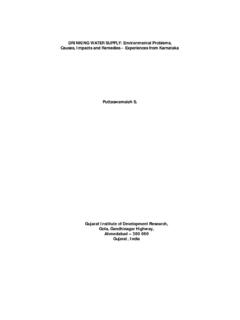Transcription of Banking Sector Reforms and NPA: A study of Indian ...
1 Banking Sector Reformsand NPA: A study ofIndian commercial BanksMeenakshi RajeevH P MaheshISBN 978-81-7791-108-4 2010, Copyright ReservedThe Institute for Social and Economic Change,BangaloreInstitute for Social and Economic Change (ISEC) is engaged in interdisciplinary researchin analytical and applied areas of the social sciences, encompassing diverse aspects ofdevelopment. ISEC works with central, state and local governments as well as internationalagencies by undertaking systematic studies of resource potential, identifying factorsinfluencing growth and examining measures for reducing poverty. The thrust areas ofresearch include state and local economic policies, issues relating to sociological anddemographic transition, environmental issues and fiscal, administrative and politicaldecentralization and governance.
2 It pursues fruitful contacts with other institutions andscholars devoted to social science research through collaborative research programmes,seminars, Working Paper Series provides an opportunity for ISEC faculty, visiting fellows andPhD scholars to discuss their ideas and research work before publication and to getfeedback from their peer group. Papers selected for publication in the series presentempirical analyses and generally deal with wider issues of public policy at a sectoral,regional or national level. These working papers undergo review but typically do notpresent final research results, and constitute works in Sector Reforms AND NPA: A study OF Indian commercial BANKS Meenakshi Rajeev and H P Mahesh 1 Abstract The issue of non-performing assets (NPA), the root cause of the recent global financial crisis, has been drawing the attention of the policy makers and academicians alike.
3 The problem of NPAs, which was ignored till recently,has been given considerable attention after liberalisation of the financial Sector in India. This exploratory paper examines the trends of NPAs in India from various dimensions and explains how mere recognition of the problem and self-monitoring has been able to reduce it to a great extent. It also shows that public Sector banks in India, which function to some extent with welfare motives, have as good a record in reducing NPAs as their counterparts in the private Sector . The paper also discusses the role of joint liability groups (JLGs) or self help groups (SHGs) in enhancing the loan recovery rate. Introduction It has been argued by a number of economists that a well-developed financial system enables smooth flow of savings and investments and hence, supports economic growth (see King and Levine, 1993, Goldsmith, 1969).
4 A healthy financial system can help achieve efficient allocation of resources across time and space by reducing inefficiencies arising out of market frictions and other socio-economic factors. Amongst the various desirable characteristics of a well-functioning financial system, the maintenance of a few non-performing assets (NPA) is an important one. NPAs beyond a certain level are indeed cause for concern for everyone involved because credit is essential for economic growth and NPAs affect the smooth flow of credit. Banks raise resources not just on fresh deposits, but also by recycling the funds received from the borrowers. Thus, when a loan becomes non-performing, it affects recycling of credit and credit creation.
5 Apart from this, NPAs affect profitability as well, since higher NPAs require higher provisioning, which means a large part of the profits needs to be kept aside as provision against bad loans. Therefore, the problem of NPAs is not the concern of the lenders alone but is, indeed, a concern for policy makers as well who are involved in putting economic growth on the fast track. In India due to the social Banking motto, the problem of bad loans did not receive priority from policy makers initially. However, with the reform of the financial Sector and the adoption of international Banking practices the issue of NPAs received due focus. Thus, in India, the concept of NPA came into the reckoning after Reforms in the financial Sector were introduced on the recommendations of the Report of the Committee on the Financial System (Narasimham, 1991) and an appropriate accounting system was put in place.
6 1 Professor and Head, CESP, Institute for Social and Economic Change, Bangalore-72. E-mail: and Senior Analyst, Economic Research and Consulting Unit of the Swiss Re Shared Services (India) Pvt. Ltd. (The views expressed by the author do not represent those of the institution where he is currently working.) This paper has benefited from an earlier project carried out under SANEI. The authors are grateful to SANEI for its support. 2 Broadly speaking, NPA is defined as an advance where payment of interest or repayment of installment of principal (in case of term loans) or both remains unpaid for a certain period2. In India, the definition of NPAs has changed over time.
7 According to the Narasimham Committee Report (1991), those assets (advances, bills discounted, overdrafts, cash credit etc.) for which the interest remains due for a period of four quarters (180 days) should be considered as NPAs. Subsequently, this period was reduced, and from March 1995 onwards the assets for which the interest has remained unpaid for 90 days were considered as NPAs. Though the NPA issue has received considerable attention in the post reform period, academic work on the subject in not adequate (Ghosh, 2005, Mor and Sharma, 2003, Rajaraman et al, 1999). This paper attempts to provide an overview of the NPA problem in India concentrating on the various dimensions involved.
8 Against this backdrop, the paper is arranged as follows. The next section compares India with few other countries across the globe. reform measures and the consequent changes in NPA norms are discussed in Section 3. The next two sections look at the loan recovery mechanisms that are in place, including the legal Reforms and the recovery trends. Trends in NPAs both at the bank level and at the Sector level are analysed in the penultimate section. The paper ends with a concluding section. NPAs at the Global Level In order to get a global picture3 it is essential to look at the NPAs in the different countries of the world. Since the concept of NPA developed in India only in the post- reform era, it would be useful to look at recent figures rather than adhere to a historical account.
9 A closer look at the Non-performing Loans (NPL), as they are called in many nations, reveals that in 2003 the NPL at the global level was US$ 1,300 billion. India ranks fourth with NPL of around US$ 30 billion ( per cent of the global NPL), while Japan has the highest NPL of US$ 330 billion ( per cent of the global NPL) and Turkey has the lowest NPL of US$ 8 billion ( percent of global NPL, Table 1). Table 1: Global Non-performing Loans: 2003 Countries NPLs (US$ billion) Share in Global (per cent) Japan 330 China 307 Taiwan Thailand Philippines 9 Indonesia India 30 Korea 15 Germany 283 Turkey 8 Global 1300 100 Source: Global NPL Report 2004, Ernst and Young.
10 2 This time duration given for an asset to consider it as a NPA varies from country to country and can change over time within a particular country. 3 See Munchisa, Kasuya (1998), Bonin et al (2001), Krueger et al (1999), Kunt et al (1997). 3 Though a clear picture of the magnitude of NPA emerges from the absolute values, it does not reveal the complete picture mainly because the absolute level of NPA depends on total advances. A country with a large population or GDP may have large advances and, in turn, larger NPA as well. Thus, apart from the absolute value, it is also important to look at what proportion of the total loan has become non-performing.









